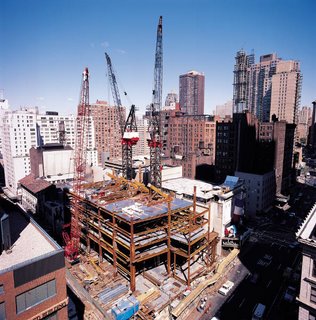
This week, after a stay of just over a year, my fiancé and I are packing up and leaving Los Angeles. Based on many factors that work themselves into such an equation, we have decided to move back to our place of origin – New York City. We turn back towards the east, knowing that New York is where we want to be. But as we tape up the final box, I look back at our time here with great affection. I came out here to try my hand at writing for television and film. Although I see it as a success, meeting a number of wonderful people, and I intend to continue my pursuit in New York, I did not “make a sale” while here. But the other learning experience I had while living in Los Angeles was the ability to enjoy a first hand experience of one of the most intriguing metropolitan regions on earth from a land use perspective. Los Angeles has always been the model of what not to do when it came to land use planning. Smoggy, sprawly and just plain ugly, pundits, politicians and professors have relegated it to one of the most ill-conceived settlements on earth.
Having driven the freeways, breathed the air, walked the beaches and explored its canyons, I leave this place better educated about why people continue to move here and grow this behemoth of a metropolitan area. Sure, the driving is terrible. The drivers, in fact, are even worse. There are days when it’s difficult to breathe (especially if you’re sensitive to bad air like I am). When it rains around here, the television meteorologists declare a state of emergency. Not having seasons does make you got nuts. The Los Angeles Times devotes a week’s worth of front page space to a celebrity (oh, let’s say Mel Gibson for instance) who gets stopped for having a few too many drinks. And yes, there is more silicone here than the Sahara Desert. But underneath the lunacy that defines Los Angeles is an environment that adds up to an oddly, but extremely, livable place.
Any observer of the urban condition will tell you that the key to a successful community is creating pedestrian-scale neighborhoods patched together by a collective sense of ownership. The very old joke in L.A. is that no one walks. For the most part, this is true. But nonetheless, “Los Angeles,” as constituted, is a patchwork of neighborhoods, one that blends into the next. If you travel down Sunset Boulevard, moving from the water inland, you weave through a multiplicity of different and distinct areas. Pacific Palisades leads to Brentwood. Cross over the 405 freeway and enter Westwood, which passes along the entrance to Bel Air, which evolves to Beverly Hills, which morphs into West Hollywood, which changes over to Hollywood, and so on, and so forth. You can take any path across the gigantic Los Angeles basin and find yourself traversing through a constant turnover in neighborhood after neighborhood, each with its own character and collection of denizens. The beach is very different from the Valley, the Hills provide a vast departure from Pasadena. The list and comparisons are like an old Love Connection episode, where each pair discusses how far apart the two of them live, all in the interest of dinner and a movie.
Depending on which numbers you believe, the Los Angeles metropolitan region is the densest area in the United States. The sprawl has morphed into really dense sprawl. In the process, the inhabitants have forged for themselves a place to live comfortably, for the most part. Los Angeles offers the wonderful escapes of beaches and forest, winter and summer sports all at the same time. And the places where people spend most of their time in a given year, although clogged with traffic, still provides a spot on an individual level, even to walk around once in awhile. Therefore, even though it’s time to leave, our time in L.A. was extremely well spent.
Having driven the freeways, breathed the air, walked the beaches and explored its canyons, I leave this place better educated about why people continue to move here and grow this behemoth of a metropolitan area. Sure, the driving is terrible. The drivers, in fact, are even worse. There are days when it’s difficult to breathe (especially if you’re sensitive to bad air like I am). When it rains around here, the television meteorologists declare a state of emergency. Not having seasons does make you got nuts. The Los Angeles Times devotes a week’s worth of front page space to a celebrity (oh, let’s say Mel Gibson for instance) who gets stopped for having a few too many drinks. And yes, there is more silicone here than the Sahara Desert. But underneath the lunacy that defines Los Angeles is an environment that adds up to an oddly, but extremely, livable place.
Any observer of the urban condition will tell you that the key to a successful community is creating pedestrian-scale neighborhoods patched together by a collective sense of ownership. The very old joke in L.A. is that no one walks. For the most part, this is true. But nonetheless, “Los Angeles,” as constituted, is a patchwork of neighborhoods, one that blends into the next. If you travel down Sunset Boulevard, moving from the water inland, you weave through a multiplicity of different and distinct areas. Pacific Palisades leads to Brentwood. Cross over the 405 freeway and enter Westwood, which passes along the entrance to Bel Air, which evolves to Beverly Hills, which morphs into West Hollywood, which changes over to Hollywood, and so on, and so forth. You can take any path across the gigantic Los Angeles basin and find yourself traversing through a constant turnover in neighborhood after neighborhood, each with its own character and collection of denizens. The beach is very different from the Valley, the Hills provide a vast departure from Pasadena. The list and comparisons are like an old Love Connection episode, where each pair discusses how far apart the two of them live, all in the interest of dinner and a movie.
Depending on which numbers you believe, the Los Angeles metropolitan region is the densest area in the United States. The sprawl has morphed into really dense sprawl. In the process, the inhabitants have forged for themselves a place to live comfortably, for the most part. Los Angeles offers the wonderful escapes of beaches and forest, winter and summer sports all at the same time. And the places where people spend most of their time in a given year, although clogged with traffic, still provides a spot on an individual level, even to walk around once in awhile. Therefore, even though it’s time to leave, our time in L.A. was extremely well spent.




